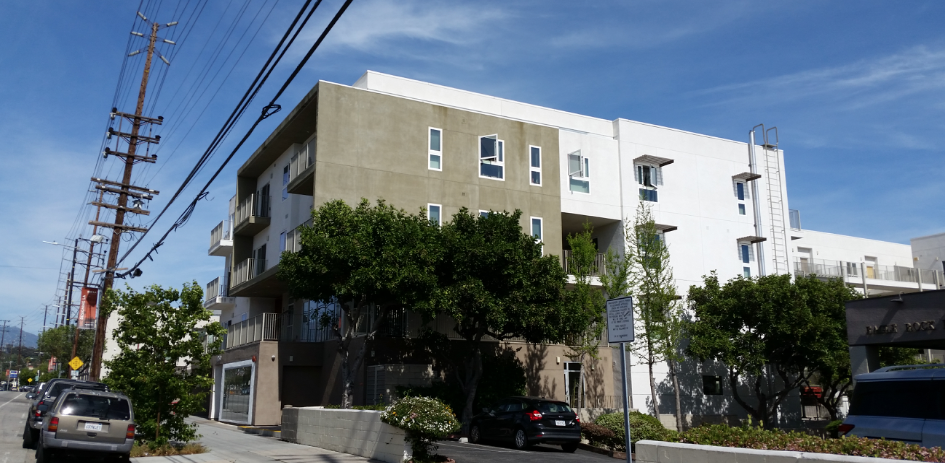CommentsHOMELESS HOUSING--The bustling sounds of rush-hour traffic weren’t heard inside the cozy multipurpose room of the Permanent Supportive Housing (PSH), Works, USA at 4260 Eagle Rock Boulevard in Los Angeles, where a tour of the site would soon be taking place.
Early this spring, the room was full of Advocates for Homeless Housing as arranged by Mary Kim, Department of Neighborhood Empowerment.
Channa Grace, Executive Director of WORKS (Women Organizing, Resources, Knowledge and Services) welcomed the advocates comprising of neighborhood council board members and stakeholders as well as representatives from the Mayor’s Office, Ana Gomez and Edna Delgadillo.
Ms. Grace is the developer and owner of the permanent supportive housing of 56 units with 7 singles, 48 one-bedroom and a two-bedroom unit for the manager, which construction was completed in 2015. Total development costs were approximately $18 million with funds received from city, county, state, and federal institutions, per handout distributed during the tour.
Grace told the story from the initial testing of the soil, trucking it to a dump and setting goals with the architect prior to braking ground for construction. The goal was to build housing that provided a sense of community within a community that’s safe and comfortable with housing retention. This effort is structured differently from public housing, she said.
Celina Alvarez Executive Director of Housing Works led the tour and Enrique Vergara, on-site manager, walked along answering questions. Alvarez has been working with housing for 30 years, is well versed on the workload that permanent supportive housing requires and the provision of services needed to meet the demands of the residents. She said that about 80% of on-site clients have at one time or another been addicted to either medical or street drugs.
Service providers offer a variety of on-site programs such as individual case management, life skills, assistance in daily living, activities for persons with developmental disabilities, mental health services, and substance abuse assistance as well as community, social and recreational activities involving gardening, exercise classes and holiday celebrations, per handout distributed during the tour. Providers are Housing Works, Los Angeles County Department of Mental Health, East Los Angeles and Lanterman Regional Centers.
Population served falls into the economic category of very low-income with developmental disabilities, or formerly homeless veterans, or other homeless persons with special needs. Included are formerly homeless households such as “Project Based Section 8 tenants paying 30% of their incomes toward rent and non-homeless households paying $363 to $595 for a one-bedroom unit,” per handout distributed during the tour.
The tour visited three residents and listened to their testimonies on what their lives were like before and after being housed. This article briefly covers the stories of two out of those three residents.
Starting on the ground floor, Dorothy Edwards welcomed the tour into her one-bedroom apartment. Edwards told about having been homeless, with dependency on alcohol, for years in the City of Pasadena. “In 2011, Housing Works CA, the on-site supportive service provider, lounged the One-Hundred Thousand Homes across America, an effort that engaged in outreach and placement for the most vulnerable and chronically homeless neighbors,” said Edwards, “and most likely to die on the streets within a year if left homeless.”
For the last seven years, Edwards has been residing at Works, USA. She is celebrating six-years of sobriety and is the coordinator of on-site enriched services from Twelve-Steps to Arts and Crafts. In addition, she gives presentations at the United Homeless Healthcare case Management Institute, the CSH Los Angeles supportive Housing Institute and at numerous housing conventions across the country speaking on the Housing First Model/Harm Reduction Empowerment.
The tour continued to the third floor and stopped at Frank Smith’s apartment. Tapestries and artwork lined the interior walls of his unit. A couple of small antique lamps hung from the ceiling, and below, carved wooden furniture was neatly arranged in a floor area of about 600 sq. ft. It was evening and still the light from the outside came through the large opened window and brightened the room. Smith is HIV-positive who seemed content in his self-designed environment after a ten-year struggle to make things work. “I lived in my van for three years with my bulldog before coming to Works, USA,” he said. “I didn’t stay in temporary shelters because they wouldn’t take me with my dog.” Smith is thankful because Works, USA accepted him three years ago with his bulldog.
“I get a lot of support and see a case manger who helps me fill out the bunch of paperwork that goes along with staying here,” he said with a smile.
The name of the last resident mentioned in this article is fictitious for privacy.
(Connie Acosta was part of the tour, is an independent writer and a member of the Los Angeles Press Club.)
-cw
















